Eclipse in Shymkent
1 August, 2008, 01:39 am in "Kazakhstan"
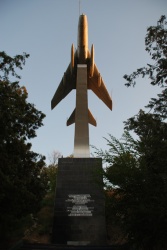 In Kazakhstan, one must get used to large spaces between one place and another. The bus ride from Turkistan to Shymkent was 3 hours. We passed a few small villages but mostly the landscape was flat plains--greener than the ones we went by yesterday, with corn and other crops occasionally breaking the stretches of wild grasses. As we drove out of Turkistan, we passed brick factories with piles of adobe bricks drying in the sun. Murat had pointed out the drying platforms the day before.
In Kazakhstan, one must get used to large spaces between one place and another. The bus ride from Turkistan to Shymkent was 3 hours. We passed a few small villages but mostly the landscape was flat plains--greener than the ones we went by yesterday, with corn and other crops occasionally breaking the stretches of wild grasses. As we drove out of Turkistan, we passed brick factories with piles of adobe bricks drying in the sun. Murat had pointed out the drying platforms the day before. There were herds of livestock: cattle and sheep, dotting the plains. We also saw a herd of camels. The bus did not have windows that opened. However, it did have vents that worked enough to blow some air at us. As usual, the person who threw up during the ride (a child sitting on his sleeping fathers lap) was sitting in one of the seats surrounding us. I wonder if we should start warning people.
Shymkent appeared to be lost in a cloud of dust as we drove in. Everything looked murky. I began to think the LP author who wrote it was a "vibrant" city had spent too much time in the desert.
We caught a bus to the center which traveled in a big zig zag making it seem like the city was huge. I kept asking if we had gotten to Ordabashi Square since LP said it was only 1.5 km from the bus station. A woman next to me reported it was "eshyo daleko" (still far). We began talking. She guessed I was a tourist right off. She was from Almaty but in town visiting her mother.
Eventually we reached our stop. (Later I realized that we were not at the main bus station mentioned in LP but at a different one, farther from the center).
Shymkent is actually a surprisingly attractive city. It doesn't have amazing landmarks but it has tall trees shading the sun drenched streets, and several shade filled parks-- a welcome relief after the dry landscape surrounding it. It feels like an oasis-- maybe it is. At a modern mall, we saw kids ice skating with really cool ice skating trainers.
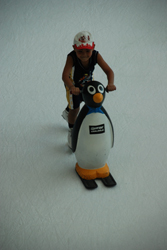
As we wandered around town blasted by the hot wind, R detected a slight cooling of temperature and the slightest change of light-- manifested by a faint unbleaching of the afternoon sky. "The eclipse!" he said. I looked at the shadows of the trees and saw the tell-tale marbled paper like patterns created by multitudes of tiny crescents of light-- the echo in miniature of the moon's shadow across the sun. To be sure, I punched a hole in my notebook cover which also revealed a little crescent of light being blocked by a shadow. We were too far South to see the full eclipse but it felt like we were in on a beautiful secret as we delighted in the patterned shadows and saw people giving us stranger than usual looks. At last we came upon a group of women and a girl viewing the eclipse through folded up pieces of film negatives. We had a look.
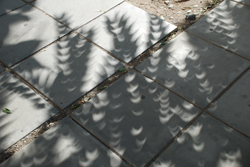
Our walk led us in a circle through town, stopping by a statue of Al-Farabi, and ending up back at the hotel.
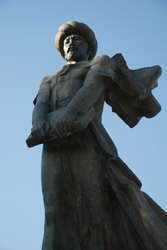
Across from the hotel is a pretty mosque whose roof shone in the sunset light.
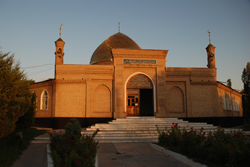
We walked up a hill and found a park with interesting statues, probably based on traditional designs.
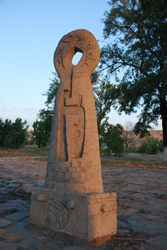
Kazakhstan needs a patient approach. Don't look for days packed with sightseeing but rather days gradually getting a sense of the place: the details of life that make it Kazakhstan, the warmth and friendly curiosity of the people, the blend of cultures that becomes visible in food, decoration, and architecture. Watch the open spaces. Rejoice in the occasional architectural wonder. Soak in the energy of the pilgrimage sights, the admiration, the voices of prayers. Enjoy the time you have and look at the details.
Comments
- Comments
Powered by My Blog 1.69. Copyright 2003-2006 FuzzyMonkey.net.
Created by the scripting wizards at FuzzyMonkey.net..
(Code modified by Rowshan Dowlatabadi)
Created by the scripting wizards at FuzzyMonkey.net..
(Code modified by Rowshan Dowlatabadi)

